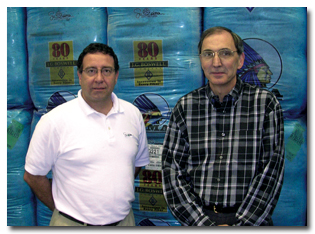A
s in many manufacturing industries, relationships among suppliers within the supply chain
vary from being close collaborations to distant relationships with faceless merchants. But, for
better brands to succeed, close collaboration within the supply chain can ensure improved product
quality and delivery as well as provide valuable problem-solving capabilities.
Case in point: During a recent
Textile World
interview, David Sasso, vice president, sales, Jefferson, Ga-based Buhler Quality Yarns
Corp., explained how a major U.S. retailer requested the technical experience of Buhler’s staff to
help investigate a quality issue with a house-branded garment.
Buhler was engaged in a program supplying high-end Supima
® cotton yarn to a well-known knitting and finishing operation in Honduras. The
resultant women’s top, however, did not meet the brand’s expectations, notably regarding pilling
and stability.
“This was an unusual situation,” Sasso said. “We knew the yarn was up to specification and
performing well in similar applications. We knew the knitter and finisher was a solid supplier. But
the final product left room for improvement.
“What’s really important is that the retailer knew us and knew we have expertise in the
dyeing and finishing of garments made with Buhler yarns,” Sasso continued. “For a number of years
now, Victor Almeida has been with Buhler in technical service and sales and has brought additional
depth to the team. Developing close relationships with retailers and brands means we work hard to
make sure they know we bring more to the supply chain than a cone of yarn.”
“We were able to go through the knitting and finishing processes and get another set or two
of eyeballs on the product,” Almeida said. “The knitter does a great job, and we really came
together to save the program and perform for the retailer.

Left to right: Buhler Quality Yarns Corp.’s David Sasso and Victor Almeida worked with
supply chain partners to correct a quality problem in a major retailer’s house-branded
garment.
“As it turns out, the problem was in the dyehouse,” Almeida explained. “When the dyeing
machine was being loaded, the rope of Supima fabric was shorter than the ropes of other fabrics
being loaded into the same machine. So, during the dye cycle, the Supima rope was traveling through
the jet some three times the distance as the other fabric, and really taking a beating. We simply
equalized the length of the ropes running together in the dyeing process and the results were
great. Overall, the garment’s pilling was reduced and the product’s stability was corrected.”
“Everybody won,” Sasso added. “The retailer knew the chain was delivering. Our relationship
with the knitter was better than ever, and the product performed the way it was supposed to.
“I know this is a Buhler example, but I think it is broader than that,” Sasso said. “I’m not
convinced that the value of a collaborative supply chain is really understood. It is easy to
undervalue. There is a tremendous wealth of information along the supply chain. You’d be surprised
what logistics people know, what knitters and dyers know — often about things upstream or
downstream from their own operation. ”
Not every supply chain is capable of performing in a collaborative way. It takes an openness
and trust that is built over time. But, as with the Buhler case, the retailer was the key to
success. With the retailer requesting participation, members of the chain were that much more
willing and open to solving the brand’s problem.
“It was a big win,” Sasso said. “Both of our companies got that much closer to the retailer,
and I think we demonstrated real value to them. And, hopefully, that will lead to that much more
business. With a high-end product like this, if the retailer knows the full supply chain will
perform — knows that when problems come up, we’ll get to the bottom of it quickly rather than pass
the buck — there is a confidence in the chain and a real competitive advantage.”
July/August 2010




